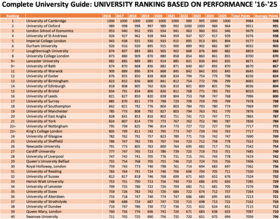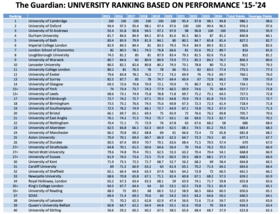|
Rankings of universities in the United Kingdom
Three national rankings of universities in the United Kingdom are published annually by The Complete University Guide, The Guardian and jointly by The Times and The Sunday Times. Rankings have also been produced in the past by The Daily Telegraph and Financial Times. UK Universities also rank highly in global university rankings with 8 UK Universities ranking in the top 100 of all three major global rankings as of 2023/24: QS World University Rankings, Times Higher Education World University Rankings and Academic Ranking of World Universities. The primary aim of the rankings is to inform potential undergraduate applicants about UK universities based on a range of criteria, including entry standards, student satisfaction, staff/student ratio, academic services and facilities expenditure per student, research quality, proportion of Firsts and 2:1s, completion rates and student destinations.[1][2] All of the league tables also rank universities on their strength in individual subjects. Each year since 2008, Times Higher Education has compiled a "Table of Tables" to combine the results of the 3 mainstream league tables. In the 2022 table, the top 5 universities were the University of Oxford, the University of Cambridge, the University of St Andrews, the London School of Economics and Imperial College.[3] RankingsThe following rankings of British universities are produced annually: The Complete University Guide The Complete University Guide is compiled by Mayfield University Consultants and was published for the first time in 2007.[4] The ranking uses ten criteria, with a statistical technique called the Z-score applied to the results of each.[5] The effect of this is to ensure that the weighting given to each criterion is not distorted by the choice of scale used to score that criterion. The ten Z-scores are then weighted (as given below) and summed to give a total score for each university. These total scores are then transformed to a scale where the top score is set at 1,000, with the remainder being a proportion of the top score. The ten criteria are:[6]
The most recent league table (2025) ranked the top 40 (out of 130) British universities as follows:[7] The Guardian The Guardian's ranking uses nine different criteria, each weighted between 5 and 15 per cent. Unlike other annual rankings of British universities, the criteria do not include a measure of research output.[8] A "value-added" factor is included which compares students' degree results with their entry qualifications, described by the newspaper as being "[b]ased upon a sophisticated indexing methodology that tracks students from enrolment to graduation, qualifications upon entry are compared with the award that a student receives at the end of their studies".[1] Tables are drawn up for subjects, with the overall ranking being based on an average across the subjects rather than on institutional level statistics. The nine criteria are:[9]
The most recent league table (2025) ranked the top 40 (out of 122) British universities as follows:[10] The Times/The Sunday TimesThe Times/The Sunday Times university league table, known as the Good University Guide,[11] is published in both electronic and print format. Since 1999, the guide also recognises one university annually as University of the Year. It ranks institutions using the following eight criteria:[12]
Other criteria considered are:
Summary of national rankingsThe following universities rank in the top 10 in at least two of the most recent national rankings (the three discussed above: the Complete, Guardian and Times/Sunday Times). The table is ordered according to the average rank in the tables for that year.[a] The last column gives the number of league tables (not including the Table of Tables) which include that university in their top ten.
Notes: Disparity with global rankingsIt has been commented by The Sunday Times that a number of universities which regularly feature in the top ten of British university league tables, such as St Andrews, Durham and LSE (in the case of LSE 3rd to 4th nationally whilst only 101–150th in the ARWU Rankings / 56th in the QS Rankings / 37th in the THE Rankings), "inhabit surprisingly low ranks in the worldwide tables", whilst other universities such as Manchester, Edinburgh and KCL "that failed to do well in the domestic rankings have shone much brighter on the international stage".[14] The considerable disparity in rankings has been attributed to the different methodology and purpose of global university rankings such as the Academic Ranking of World Universities, QS World University Rankings, and Times Higher Education World University Rankings. International university rankings primarily use criteria such as academic and employer surveys, the number of citations per faculty, the proportion of international staff and students and faculty and alumni prize winners.[15][16][17] When size is taken into account, LSE ranks second in the world out of all small to medium-sized specialist institutions (after ENS Paris) and St Andrews ranks second in the world out of all small to medium-sized fully comprehensive universities (after Brown University) using metrics from the QS Intelligence Unit in 2015.[18] The national rankings, on the other hand, give most weighting to the undergraduate student experience, taking account of teaching quality and learning resources, together with the quality of a university's intake, employment prospects, research quality and drop-out rates.[1][19] The disparity between national and international league tables has caused some institutions to offer public explanations for the difference. LSE for example states on its website that 'we remain concerned that all of the global rankings – by some way the most important for us, given our highly international orientation – suffer from inbuilt biases in favour of large multi-faculty universities with full STEM (Science, Technology, Engineering and Mathematics) offerings, and against small, specialist, mainly non-STEM universities such as LSE.'[20] Research by the UK's Higher Education Policy Institute (HEPI) in 2016 found that global rankings fundamentally measure research performance, with research-related measures accounting for over 85 percent of the weighting for both the Times Higher Education and QS rankings and 100 percent of the weighting for the ARWU ranking. HEPI also found that ARWU made no correction for the size of an institution. There were also concerns about the data quality and the reliability of reputation surveys. National rankings, while said to be "of varying validity", have more robust data and are "more highly regarded than international rankings".[21] British Universities in global rankingsThe following universities rank in the top 100 in at least two global rankings:
Notes: CriticismAccuracy and neutralityThere has been criticism of attempts to combine different rankings on for example research quality, quality of teaching, drop out rates and student satisfaction. Sir Alan Wilson, former Vice-Chancellor of the University of Leeds, argues that the final average has little significance and is like trying to "combine apples and oranges".[25] He also criticised the varying weights given to different factors, the need for universities to "chase" the rankings, the often fluctuating nature of a university's ranking, and the catch-22 that the government's desire to increase access can have negative effects on league table rankings.[25] Further worries have been expressed regarding marketing strategies and propaganda used to chase tables, thus undermining universities' values.[26] The Guardian suggests that league tables may affect the nature of undergraduate admissions in an attempt to improve a university's league table position.[27] Roger Brown, the former Vice-Chancellor of Southampton Solent University, highlights perceived limitations in comparative data between Universities.[28] Writing in The Guardian, Professor Geoffrey Alderman makes the point that including the percentage of 'good honours' can encourage grade inflation so that league table position can be maintained.[29] The rankings are also criticised for not giving a full picture of higher education in the United Kingdom. There are institutions which focus on research and enjoy a prestigious reputation but are not shown in the table for various reasons. For example, the Institute of Education, University of London (now part of UCL), was not usually listed in the undergraduate rankings despite the fact that it offered an undergraduate BEd and was generally recognised as one of the best institutions offering teacher training and Education studies (for example, being given joint first place, alongside Oxford University, in the 2008 Research Assessment 'Education' subject rankings, according to both Times Higher Education and The Guardian).[30][31] The INORMS Research Evaluation Group have developed an initiative called More Than Our Rank[32] which allows universities to describe in a narrative format their activities, achievements and ambitions not captured by any university ranking. Full-time biasLeague tables, which usually focus on the full-time undergraduate student experience, commonly omit reference to Birkbeck, University of London, and the Open University, both of which specialise in teaching part-time students. These universities, however, often make a strong showing in specialist league tables looking at research, teaching quality, and student satisfaction. In the 2008 Research Assessment Exercise, according to the Times Higher Education, Birkbeck was placed equal 33rd, and the Open University 43rd, out of 132 institutions.[33] The 2009 student satisfaction survey placed the Open University 3rd and Birkbeck 13th out of 153 universities and higher education institutions (1st and 6th, respectively, among multi-faculty universities).[34] In 2018, Birkbeck announced that it would withdraw from UK university rankings because their methodologies unfairly penalise it, since "despite having highly-rated teaching and research, other factors caused by its unique teaching model and unrelated to its performance push it significantly down the ratings".[35] NotesReferences
External links |